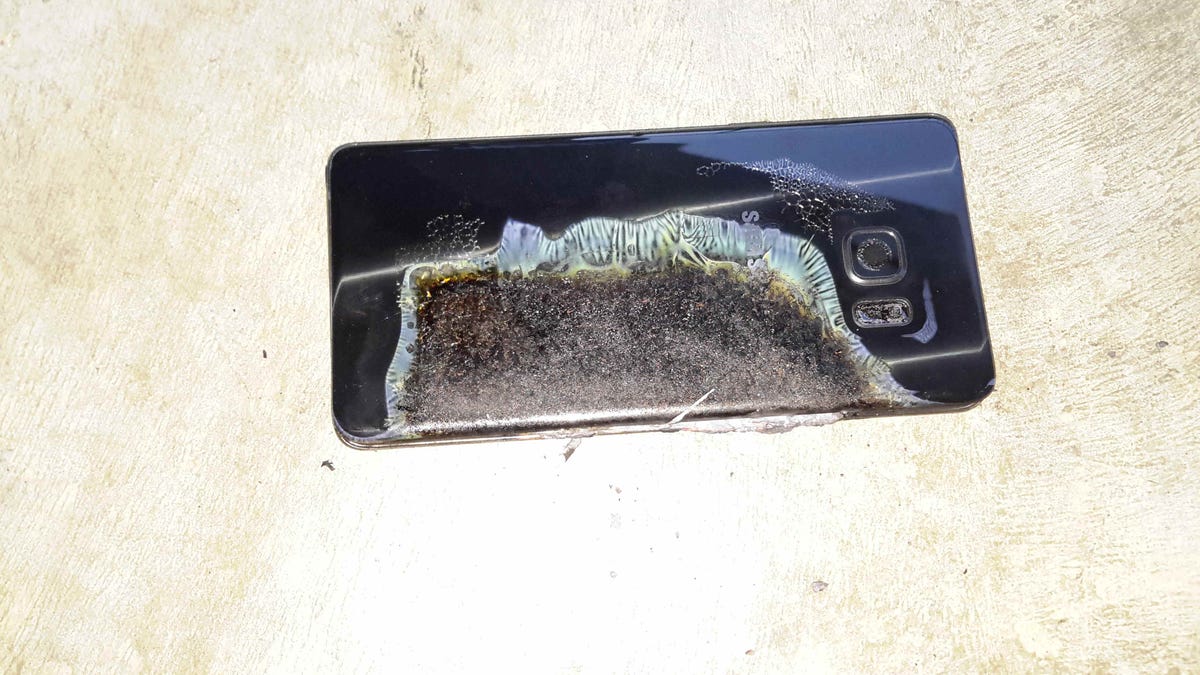Should you fear your phone battery?
Commentary: A second round of Galaxy Note 7 phones appear to have spontaneously combusted. Could your phone be next? Here's how to put the fear into perspective.

You've no doubt heard the news: Samsung has permanently stopped producing its Galaxy Note 7, after as many as five of the supposedly "safe" replacement phones were said to explode. Samsung and the US Consumer Product Safety Commission are advising that every single Note 7 owner power their phones down. (Owners can trade them in for different phones.)
But here's the thing: no matter which phone you own -- Android, iPhone, even an old BlackBerry -- your phone likely includes a flammable lithium-ion battery, too. (The same goes for most tablets, laptops and many other portable devices.)
If Note 7 batteries are melting down -- even if it's just a small handful -- is your phone next? Could you wake in the middle of the night to see your nightstand smoldering, or worse?
The short answer: It's highly unlikely. Phone batteries aren't statistically likely to explode -- even the ones inside the original, pre-replacement Samsung Galaxy Note 7 phones.
But it's not impossible.
Statistically rare (unless it happens to you)
Last month, an unnamed Samsung official told Yonhap News that only 0.01 percent of all Note 7 handsets sold had the battery manufacturing defect. That's fewer than 100 out of the 1 million Note 7 phones involved in the initial recall.
Of course, that math needs to be updated now that some replacement phones also caught fire. But if you exclude the admittedly problematic Note 7, only 1 in 10 million lithium-ion battery cells are likely to go bad, according to battery expert Brian M. Barnett, as quoted by Chemical & Engineering News in 2013. That's 0.00001 percent -- somewhere between being struck by lightning in the US in a given year (1 in 1,042,000) and winning a recent Powerball lottery jackpot (1 in 292 million).
The video above is what happens when you puncture a phone's battery.
Pretty infinitesimal odds. So why the concern? Because we're absolutely surrounded with these rechargeable lithium-ion batteries now. Power tools use them; some hearing aids and greeting cards do too. Your laptop, your tablet, your Bluetooth speaker and every smartphone you've ever owned likely used a lithium battery. Prior to the Note 7, when was the last time you heard about them exploding?
Larger battery fires can do serious damage: Jessica Horne lost her family's Louisiana home after her 12-year old son's Fit Turbo hoverboard exploded in 2015.
At CNET, we cover tech for a living, and we can tell you it does happen -- once in a blue moon. First, there are the near misses: Intel recalled the Basis Peak wearable in August due to overheating concerns. And back in 2015, Nvidia recalled nearly every Shield tablet because its battery was judged unsafe.
But it's the thought of exploding phones, which have become such an key part of modern life, where anxiety really ramps up.
"Nobody expects a battery to cause problems," says John Drengenburg, consumer safety director for Underwriters Laboratories (UL). "Clearly it's very rare, but when something like that does happen, it's quite impactful and high visibility,"
It's one thing when the phone's structural integrity is compromised. That's what happened when our Droid Turbo 2 burned after we deliberately tried to crack its "shatterproof" screen, as seen in the video above. (The screen mostly survived, even if the battery didn't.) Similarly, a Sydney, Australia, man suffered nasty burns after he fell off a bike and crushed his iPhone 6 .
But the bigger problem is when phones appear to spontaneously combust. The Note 7 may not be the only phone blowing up this October: here's a flaming iPhone from New Jersey and another one from California. Both were said to be the iPhone 6 Plus , first sold back in 2014.
(CNET hasn't independently confirmed the details of either incident. Apple declined to comment.)
"When you look at the hundreds of millions of phones, laptops, hoverboards, and other consumer products in the marketplace and compare it with the number of incidents and recalls, it can be said that lithium-ion fires are rare. But, they are serious incidents when they happen," Scott Wolfson, spokesman for the US Consumer Product Safety Commission, told CNET.
Car crashes and gas explosions
So, should you ditch your smartphone and laptop, and go back to a landline, an old Nintendo Game Boy with AA batteries and a big ol' desktop PC? That's certainly one option.
Of course, you might also want to stop driving (there's roughly a 1 in 10,000 chance of dying in a car crash every year). And I definitely hope you don't have a gas line in your home: they can, and occasionally do, explode.
You get the point. Those are tragic occurrences that happen all too often. But like a phone battery fire, it's highly unlikely to happen to you.
It's probably not worth the risk.
The exception to the rule
Still, there's no point tempting fate where the Galaxy Note 7 is concerned. Not when the Note 7 may have the highest rate of battery failure of any consumer device recorded.
According to Battery University, the failure rate of the infamous exploding Sony laptop batteries was just 1 in 200,000. 5 parts per million. The giant Nokia battery recall (reportedly the largest in history) was based on a failure rate of less than 3 parts per million.
Remember the unnamed Samsung official who said as many as 0.01 percent of the original Samsung Galaxy Note 7 phones had the defect? That's 100 parts per million. Or 1 in 10,000 -- the same likelihood as dying in a car accident in the US in any given year.
If you're worried about any other phone, you're probably safe and sound. But if you're wielding a Samsung Galaxy Note 7, you should return it now.

